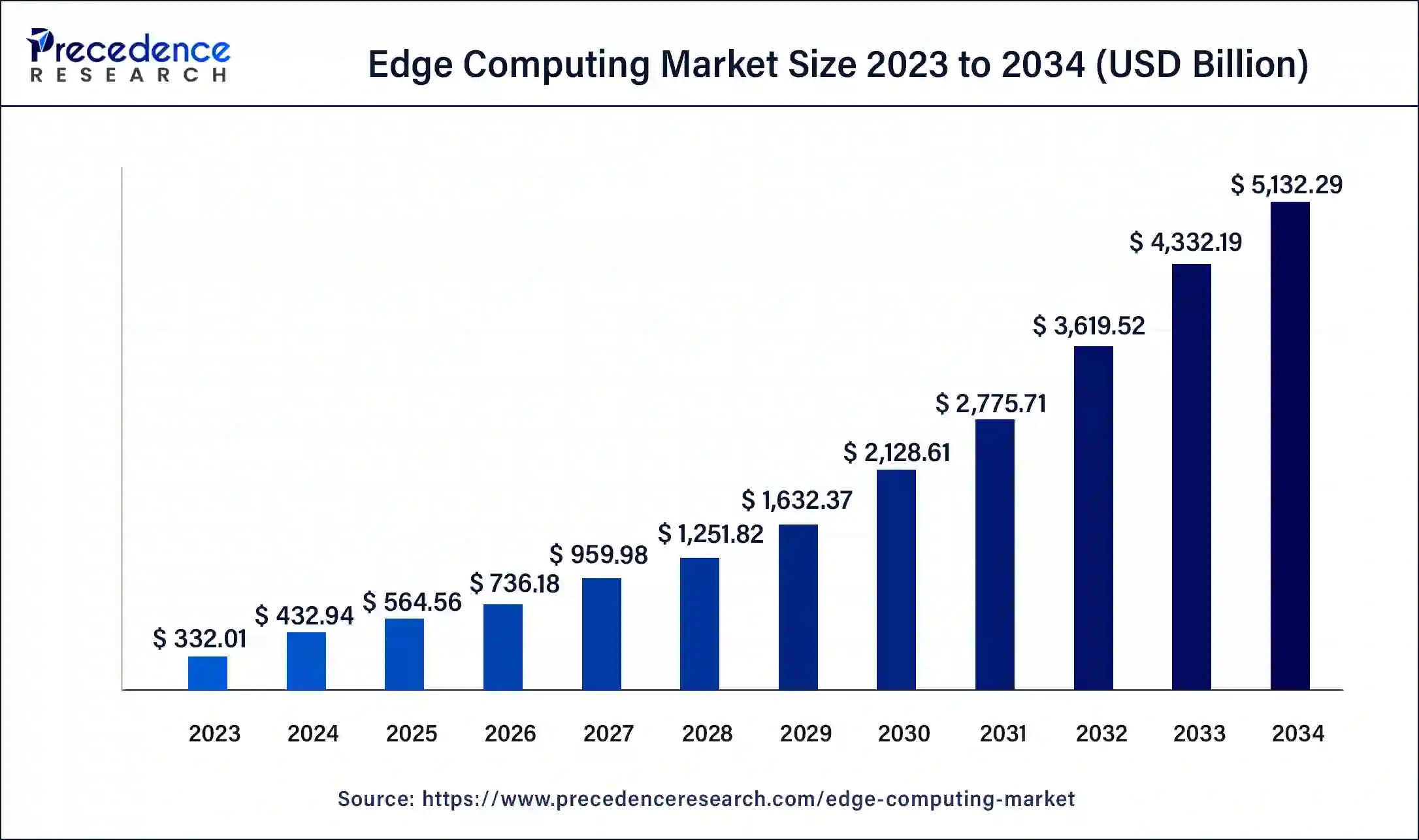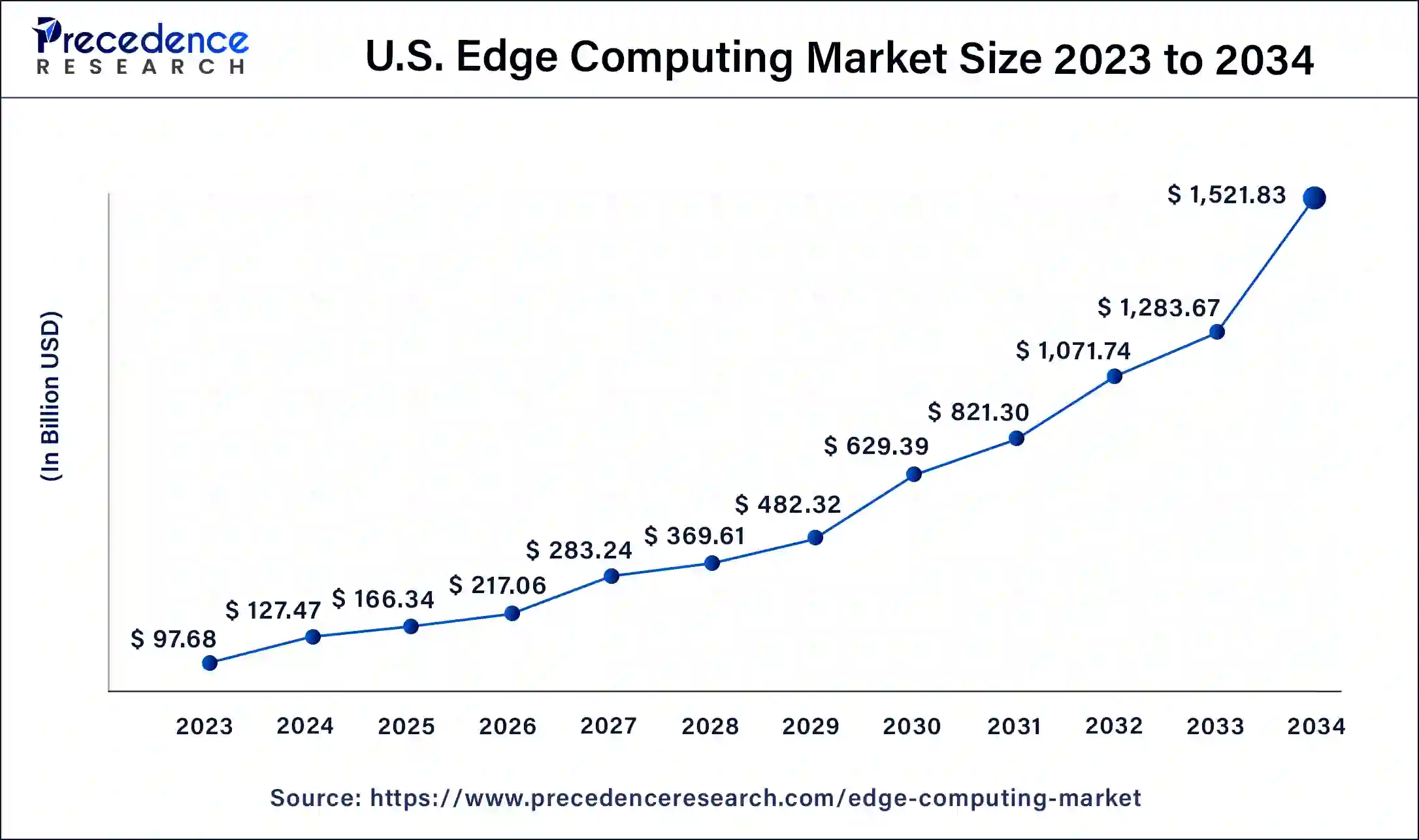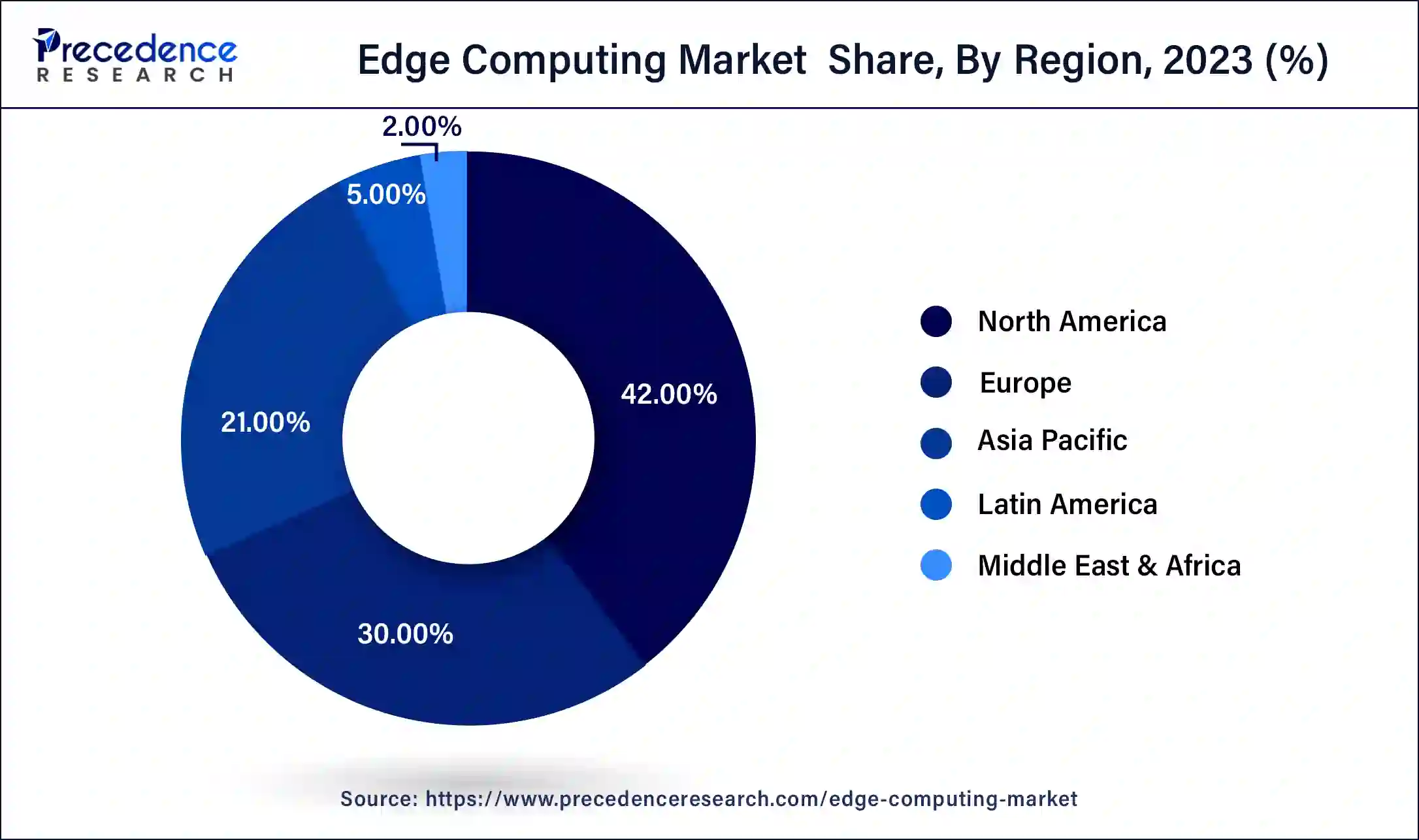List of Contents
Edge Computing Market Size and Forecast 2025 to 2034
The global edge computing market size is calculated at USD 432.94 billion in 2024 is predicted to increase from USD 564.56 billion in 2025 to approximately USD 5,132.29 billion by 2034, growing at a CAGR of 28% from 2025 to 2034.

Edge Computing Market Key Takeaway
- North America region garnered the largest market share 42% in 2024.
- By component, the server sector held more than 45.5% of total revenue in 2024.
- The revenue share of edge sensors/routers was 25% in 2024.
- The energy and industrial category accounted for more than 18.6% of total revenue in 2024.
- The Industrial Internet of Things (IIoT) application category had a revenue share of more than 33% in 2024.
AI in Edge Computing
Edge computing leverages AI to enhance speed, security, and cost-efficacy by processing data locally and very close to the source, therefore reducing latency and granting real-time responses to key applications such as autonomous driving and industrial automation. This local processing helps with privacy preservation and also reduces bandwidth consumption and transmission costs. Edge AI works on system reliability, supports scalable deployment on devices, optimizes power consumption, and conducts smart filtering of data for transmission of only useful information. All these features make edge artificial intelligence (AI) a must-have in industrial applications for fast, secure, and sustainable computing power.
U.S. Edge Computing Market Size and Growth 2025 5o 2034
The U.S. edge computing market size was valued at USD 97.68 billion in 2024 and is expected to reach USD 1,521.83 billion by 2034, at a CAGR of 28.14% from 2025 to 2034.

North America led the edge computing market in 2024 with the largest share. North America, particularly the United States, is home to many of the world's leading technology companies and research institutions. This ecosystem fosters rapid advancements in edge computing technologies, including the development of advanced hardware, software, and integrated solutions. Major tech giants such as Amazon, Microsoft, and IBM are at the forefront of offering edge computing solutions, driving market growth through continuous innovation. Industries in North America, including healthcare, manufacturing, and retail, are increasingly adopting edge computing to enhance operational efficiency, reduce latency, and enable real-time data processing. The strong presence of these sectors, coupled with their readiness to invest in cutting-edge technologies, has significantly contributed to the region's leadership in the edge computing market.
APAC is expected to develop at the quickest proportion in the next years. APAC has seen rapid implementation of new and is expected to have the greatest CAGR throughout the projection period. Moreover, IT investment in the zone is steadily growing, which is expected to contribute to an increase in the usage of edge computing. APAC is home to a number of major telecoms and edge network firms, including China Telecom Huawei, Telstra, Vodafone, Optus, and NTT Docomo, Vodafone which contributes to the expansion of the edge computing industry. Yet, as relative to North America and Europe, APAC penetration of edge computing is modest.

This is due to the absence of understanding among many of the region's small and medium-sized businesses (based on a survey by Vertiv, acloud computingtechnology provider). The poll also revealed that the region's acceptance of edge computing is projected to skyrocket in the next 3–5 years, owing to a trend favoring edge technology across Asian retail and BFSI firms.
Edge Computing Market Growth Factors
The COVID-19 epidemic has led to a surge in edge computing and data centres. Nevertheless, with increased deployment, investment on these technologies is projected to fall modestly over the subsequent few months. To attain quick cost reductions, companies across several business verticals are lowering their expenditure or eliminating their resources in modernising software and servers. There are few outliers, such as growing expenditures in edge and IoT in the medical and telecommunications sectors. The telecom industry is growing at a high rate in video conferencing software like as Zoom and Microsoft Teams, and creative approaches are being introduced to meet the increased demand.
- For example, in December 2020, SK Telecom and Amazon Web Services developed edge cloud services centred on the 5G MEC. Corporations are seizing possibilities to address the present circumstances by delivering innovative services.
The severe acceleration in request for the edge computing and is projected to persist for the next three to four years following the COVID-19 pandemic, as the strain on expanding core network will not abate in the near future. Working from home being new normal as well as the healthcare system reaching saturation point with the online consultations, is predicted to give birth to such network architecture requires minimal connectivity and strong security. Telecom firms are likely to seize on this possibility since the cost of setting up advanced compared facilities or establishing full-sized data center will outweigh the cost of edge facilities per unit. This financial advantage will hasten telecom firms' transition to large-scale data centre development in the coming years. Edge computing has evolved into a solution-oriented technology, containing unique designs and hardware designed for specific use cases. This is the first step forward to the future in which the edge becomes a viable portion of the internet with user-friendly platforms for many developers to make the most of it.
Key Trends Influencing the Market's Future
- Proliferation of IoT devices: The rise of smart devices across industries (e.g., manufacturing, health monitoring, transportation) requires improved data management – in other words, the proliferation of IoT devices necessitates real-time, localized data processing. In turn, this is increasing the use of edge computing.
- Demand for low latency applications: Autonomous vehicles, augmented/virtual reality (AR/VR), and real-time business analytics are applications that require ultra-low latency. Edge computing enables low-latency data processing in a more efficient manner than centralized cloud computing.
- 5G implementation: The global introduction of 5G allows users to transmit data significantly faster with considerably lower latency (e.g., millisecond versus second response time). This enhanced capability can support high-bandwidth content and mission-critical applications that edge computing systems can deliver.
- Data privacy or security regulations: Data privacy regulations are increasingly restricting the movement of sensitive data. Processes of transferring sensitive information to centralized computer servers can pose significant risks, so organizations are being encouraged to process data closer to data sources.
- Increasing use of AI at the edge: New artificial intelligence technologies at the “edge” enable smart decision-making and fast data processing at the source. The increased adoption of edge computing in sectors like smart cities and industrial automation exemplifies the benefits of AI enablement.
Edge Computing Market Scope
| Report Coverage | Details |
| Market Size in 2025 | USD 564.56 Billion |
| Market Size in 2024 | USD 432.94 Billion |
| Market Size by 2034 | USD 5,132.29 Billion |
| Growth Rate from 2025 to 2034 | CAGR of 28% |
| Largest Market | North America |
| Base Year | 2024 |
| Forecast Period | 2025 to 2034 |
| Segments Covered | Component, Organization Size, Deployment, Industry Vertical, Application, and Region |
| Regions Covered | North America, Europe, Asia-Pacific, Latin America, and Middle East & Africa |
Market Dynamics
Drivers
Advancements in Edge Computing
With edge computing, data processing happens close to users and devices; thus, this minimizes latency and bandwidth costs. The lesser the distance data has to travel, the lesser the response time, enabling real-time responses. These applications will stand to benefit from increased efficiency and performance, which include industrial automation, autonomous vehicles, and smart cities. In terms of reducing network congestion and cost savings, edge computing brings a lot to the table with lessdependency on centralized cloud infrastructure. This will create a better user experience for diverse sectors.
Restraint
Challenges in Integration
Challenges of integration and interoperability continue to act as key hindrances to edge adoption. Many legacy systems may require significant changes to work with edge solutions. Its absence of standardized protocols, between devices and platforms, introduces incompatibility issues as well as data silos. Another layer is added to this complexity when managing distributed edge infrastructure comprising heterogeneous hardware and software components, requiring specialized orchestration tools and skillsets. All these complexities translate into increases in implementation costs and thus slow down deployments within various industries.
Opportunity
Emergence of Sustainable Computing Practices
Edge computing nurtures a model for sustainable computing by lessening the transmission of a huge volume of data to centralized cloud data centers. This kind of localized processing decreases the consumption of energy, which is consistent with reducing carbon emissions while also optimizing resource utilization. Such efficiency benefits environmentally conscientious enterprises while at the same time agreeing with the larger agenda of sustainability. Also, sustainable edge deployments will bring down operations costs, all while maintaining high performance, thereby creating modern forms and opportunities to pursue green, efficient, and scalable computing architectures.
Component Insights
The servers segment dominated the market in 2024. Servers that enable edge apps are often owned by organisations, linked to devices through a private network, and placed on-premises. Servers are progressively being installed in distant and edge locations, reducing latency among data producers and consumers. In addition, as the telco edge evolves, telcos are developing Multi-access Edge Computing (MEC) server architecture for information process technology.
The growing number of available centres in various industries is driving up market for edge routers. The routers serve as a gateway between both the local network and the external WAN. All data packets join the network to be routed through the entire edge router. Furthermore, the edge router is ultimately responsible for the operational security, filtering out unwanted access requests. Edge data centres must be well-equipped with diverse and strong edge routers capable of handling a high volume of traffic coming with low latency.
Edge Hardware set a scene for the dominating segment in the world of edge computing while IoT-IIoT adoption grows and more data is generated. Enterprises use edge hardware for offloading processes that otherwise take place in the cloud or in data centers, which entails maximum speed for local computation and real-time analytics. This growing demand from sectors including managed services, manufacturing, and industrial processes ensures that hardware will have the largest market share.
The software segment is expected to be the fastest-growing during the forecast period, driven by scalable, low-latency frameworks and the integration of AI. Containerization and orchestration tools, plus local intelligence, have spurred acceptance. Enterprises looking for real-time insight and automation increasingly lean toward edge-native software, supporting rapid growth for this segment.
Industry Vertical Insights
The energy and industrial category segment dominated the market in 2024. Smart grids, which operate on device edge infrastructure, are important in contributing to profitability in the energy and utilities industry. Sustainable environmental measures are pushing global attempts to enhance the effectiveness of electricity distribution services, as well as the development of alternative renewable energy sources like wind and solar. Globally, smart grids are being introduced to increase productivity improvements and offer features including as interconnection with smart appliances, real-time consumption control, and micro-grids to support distributed renewable production.
In 2024, the healthcare industry had a sizable revenue share. When it comes to the use of digital technology, the healthcare industry has always been cautious. The industry is highly controlled, with permission driving improvement rather than blatant interruption. Nonetheless, as the healthcare industry becomes more digital, hospitals and clinics are increasingly implementing digital health initiatives with variable degrees of sophistication and effectiveness. Clinics and hospitals are integrating edge computing solutions across critical use cases to enable these objectives, namely remote patient care, patient record management, intervention and constant patient monitoring.
The manufacturing segment dominated the market, supported by Industry 4.0 adoption, real-time analytics, predictive maintenance, and AI-based automation. Edge computing technologies assist production by enhancing efficiency and operational performance, further boosting their influence.
The healthcare segment is the fastest-growing as hospitals advance in digital health. Edge solutions are considered valuable for remote monitoring, patient record handling, and continuous care, allowing positive outcomes and operational efficiency.
Application Insights
The Industrial Internet of Things (IIoT) segment has dominated the market with highest revenue share in 2024. Edge computing has been critical in enabling firms to achieve facility digitalization. A major portion of edge computing in the industrial industry is implemented as machine edge. As system complexity rises and the infrastructures edge becomes more accessible, demands for edge set up to guarantee is projected to rise.
Industry 4.0 stresses speed and flexibility through the use of techniques that allow the integration of physical and cyber systems. Smart factories can use an edge platform to communicate only collected information to their cloud - based solutions. By evaluating data remotely and delivering summary data to the cloud, the edge provides a gateway. In a smart factory, for example, edge devices may proactively correct specific problems and alert plant managers to concerns on the manufacturing floor.
The IIoT dominated as manufacturing and logistics are critically in need of low-latency localized computing. Predictive maintenance, real-time insights, and smart factory modernization are enabled by edge solutions, thereby cementing the dominant position of IIoT.
AR/VR is expected to grow at the fastest rate during the forecast period. Ultra-low latency for immersive experiences drives growth in AR/VR. Near-user edge deployment ensures responsiveness and security while making bandwidth use efficient; adoption has been further pushed by the growth of 5G.
Organization Size Insights
Large enterprises have had a dominant presence in the market, mainly for handling applications and IoT data that need high volume and low latency on edge infrastructures. At least for the foreseeable future, their market dominance will be maintained with their in-built scalability, end-to-end customization attributes, and digital transformation road map.
The small & medium enterprise segment is projected to have the highest growth rate, with transformation on digital fronts to enhance agility and customer experience. SMEs must be targeted for solutions that are to be accepted and forgotten. Edge solutions that are cost-effective and scalable would grant SMEs the edge to process data locally, implement IoT, AI, and real-time analytics, and modernize operations in the least time possible, thereby bolstering the edge as the major fuel for innovation.
Recent Developments
- In October 2024, Mistral AI launched the Mistral 3B and 8B models for edge computing. These new models focus on on-device computing and edge applications, enhancing capabilities in areas such as knowledge reasoning and function-calling.
- In March 2025, Indian semiconductor startup Netrasemi is set to launch its first AI-optimized system-on-chip (SoC) for edge computing applications.
- In February 2025, Sequitor Edge, LLC, a leader in Next Generation Edge Computing Data Centers™, is excited to announce the launch of its initial data center regional operating company. Sequitor Edge is strengthening its go-to-market launch with a customer-centric focus on data centers, managed services, and expert services to provide innovative Next Gen solutions for customers' IT infrastructure needs.
Edge Computing Market Companies
- Amazon Web Services (AWS), Inc.
- ABB
- Siemens AG
- IBM Corporation
- Aricent, Inc.
- Atos
- General Electric Company
- Hewlett Packard Enterprise Development
- Cisco Systems, Inc.
- Huawei Technologies Co., Ltd.
- Honeywell International Inc.
- SAP SE
- Intel Corporation
- Microsoft Corporation
- Rockwell Automation, Inc
Segments Covered in the Report
By Component
- Hardware
- Edge Nodes/Gateways (Servers)
- Sensors/Routers
- Others
- Cameras
- Drones
- HMD
- Robots
- Others
- Hardware by Type
- Hardware by End Point Devices
- Software
- Services
- Edge-managed Platforms
By Organization Size
- Large Enterprises
- SMEs
By Deployment
- On Premise
- Cloud
By Industry Vertical
- Industrial
- Energy & Utilities
- Healthcare
- Agriculture
- Transportation & Logistics
- Retail
- Datacenters
- Wearables
- Smart Cities
- Smart Homes
- Smart Buildings
By Application
- IIoT
- Remote Monitoring
- Content Delivery
- Video Analytics
- AR/VR
- Others
By Region
- North America
- Europe
- Asia Pacific
- Latin America
- Middle East and Africa (MEA)
For inquiries regarding discounts, bulk purchases, or customization requests, please contact us at sales@precedenceresearch.com
Frequently Asked Questions
Ask For Sample
No cookie-cutter, only authentic analysis – take the 1st step to become a Precedence Research client